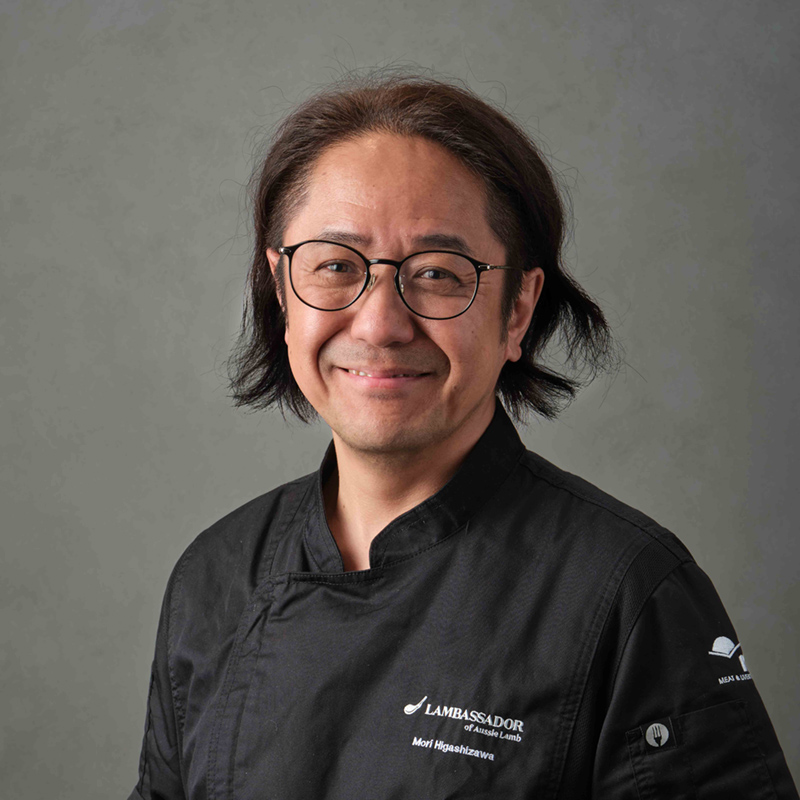 Lambassador Mori Higashizawa with MLA MENA Corporate Chef Tarek Ibrahim at the 10-year celebration of Lambassador in WA.
Lambassador Mori Higashizawa with MLA MENA Corporate Chef Tarek Ibrahim at the 10-year celebration of Lambassador in WA.
Lambassador turns 10: Celebrating a global network of Aussie lamb lovers
A decade ago, Australian lamb held an emerging presence within many global markets. Today, it’s a premium product enjoyed in more than 90 countries, with more than 359,000 tonnes shipped globally in 2024 alone – generating more than AU$3.7 billion.
Australia may produce just 7% of the world’s sheepmeat, but it punches well above its weight – accounting for over 40% of global exports, it is the world’s leading sheepmeat exporter.
Here, we celebrate Meat & Livestock Australia’s (MLA) Lambassador program’s 10th birthday.
Lambassador’s Japanese origins
It’s been 12 years since MLA’s Japan-based Senior Foodservice Manager, Kazunori Mitsuhashi, began developing opportunities to promote Australian lamb within the nation that was only consuming 200g per person annually at the time.
Employing the aid of sheepmeat butcher Mori Higashizawa – the third-generation owner of Toyo Meat in Nayoro, Japan – and with support from International Markets General Manager (at the time, Japan Regional Manager) Andrew Cox, the idea of the Lambassador program was born.
Taking inspiration from MLA’s annual ‘eat more Australian lamb’ advertising campaign that kicked off in 2005 with Sam Kekovich – dubbed the ‘Lambassador’ – the trio sought Japanese chefs and butchers who could serve as ambassadors for the Australian-grown protein.
“Japan is home to only about 25,000 sheep. With such a limited local supply, I saw a real opportunity for Australian lamb – but before we could build demand, we had to first build awareness,” Kazunori said.
Lamb built in legacy
Mori can claim to be the program’s very first Lambassador – he even helped design the logo when the program came to life in 2015 – but sharing his love for lamb is not a new concept.
Toyo Meat, which was founded by his grandfather in 1928, specialises in sheepmeat cuts and has been selling Australian-grown lamb and mutton to customers for almost 50 years.
“Until the 1980s, I had only ever seen frozen meat, so when chilled Australian lamb was first imported to Japan, it felt like a revelation,” Mori said.
“The beautiful aroma the fat produced when cooked seeded my love and desire for Australian lamb as an elementary student.
“Paired with the consistent size, balanced eating quality and lean meat yield, and strong traceability that showcased the passion and hard work behind the Australian lamb industry, my desire could only grow.”
Today, 99% of the sheepmeat Mori stocks is Australian grown.
According to Mori, the most popular sheepmeat dish in Japan is Jingisukan (Genghis Khan) – a Mongolian style barbecue that is traditionally made with lamb or mutton.
“We specialise in secondary cuts suited for Jingisukan dishes, bone-in smoked lamb hams, lamb sausages and lamb prosciutto – we even have rarer items available like pastrami from lamb hanging tender and smoked lamb tongue.
“One of the keys to promoting Australian lamb in Japan is adapting it to suit our dining styles, taste preferences and occasions,” he said.
“By crafting products that feel familiar yet exciting, we help people discover lamb in a way that fits seamlessly into their lives.”
More recently, Mori has moved beyond Japan’s borders to conduct butcher masterclasses in Thailand and Vietnam – forming global relationships through his love for Australian lamb.

Mori Higashizawa was MLA’s first Lambassador in 2015 – he even helped design the Lambassador logo.
Becoming a global phenomenon
The year 2022 marked a major milestone for the Lambassador program with the reopening of international borders following the COVID-19 pandemic.
Recognising the pivotal role of Australian lamb in keeping the Lambassadors connected with each other and Australia, Kazunori saw value in broadening the program and seeking Lambassadors from other Australian lamb export markets.
“The Victorian State Government has supported the program from the beginning,” Kazunori said.
“Their continuous backing throughout the pandemic gave us confidence to think bigger – to take Lambassador beyond Japan and into other regions where Australian lamb was gaining traction.”
Today, the program encompasses a network of 123 Lambassadors across 19 markets.
Aussie lambs’ top fansThe United States In 2024, North America became Australia’s top lamb export market, receiving 83,513t of product valued at A$1.26 billion. MLA’s Market Development Associate for North America, Andy Groneman, said the region’s appetite for Australian lamb is linked to the key elements of trust the Aussie Lamb logo represents. “We’re seeing more restaurants and retailers in the US explicitly call out ‘Australian lamb’ because it signals quality, provenance and integrity,” he said. “It fits perfectly into the kind of foodservice stories consumers care about – fresh, sustainable, grassfed, hormone-free and often halal.” Over the past decade, Australian lamb exports to the US have grown by more than 70% to now make up around 70% of total sheepmeat imports in the US. MENA Despite competing with a strong domestic supply, the Middle Eastern and North African (MENA) region was Australia’s second largest export market for lamb in 2024 – importing 98,917t valued at A$964 million. A new Free Trade Agreement between Australian and the United Arab Emirates (UAE) Comprehensive Economic Partnership Agreement, as well as the extension of shelf-life in Gulf markets from 70 to 90 days, are set to further support trade by reducing costs and expanding opportunities. MLA’s Corporate Chef for MENA, Tarek Ibrahim, has championed Australian red meat across the region since 2005. He is co-founder of six restaurants across Egypt under the Umami brand and works in educating chefs, consumers and foodservice professionals on the quality, versatility and sustainability of Australian red meat. As part of his involvement in the Lambassador program, Tarek balances the positioning of Australian lamb as a premium quality item, while also ensuring it remains in the daily consumption repertoire. “The Middle East is a unique market in being known as ‘the land of lamb’,” Tarek said. “But Australia has worked hard in making its products presence – and desirability – gradually more known. “In the last five to six years especially, Australian lamb has become more attractive to younger chefs as they gain more knowledge of Australian red meat production standards, eating quality excellence and compliance with halal certification. “The introduction of the Lambassador program to the region in 2022 enabled this knowledge to expand further amongst chefs and enable them, in turn, to educate their customers and staff. “As Lambassadors, they take what they learn through the program – from production standards to cooking techniques – and deliver it to consumers’ plates in ways that are culturally relevant and exciting.” Greater China The Greater China region is another top lamb export market for Australia, with 56,337t of sheepmeat exported in 2024, bringing in a revenue of A$376 million. While China Mainland is our top export market for frozen lamb, this year saw the approval of 17 new Australian establishments for chilled lamb – with chilled lamb export volume already tripling this October compared to 2024. |
Be a Lambassador
With the expanded global reach, the Lambassador program now includes food influencers and nutritionists in addition to chefs and butchers.
“Our continued focus is on market diversification, understanding unique market requirements and supporting marketing efforts through targeting younger and culturally diverse consumers,” Kazunori said.
“Diversifying our team of Lambassadors algins perfectly with our goal to grow demand. It also aligns with our belief that lamb brings people together.
“Our slogan is ‘Be a Lambassador’ – anyone who loves Australian lamb and shares it is a Lambassador in my books.”



